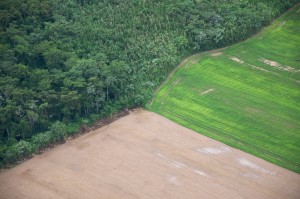18 December 2015
Rainforests not so rainy: Cutting trees cuts rainfall
Posted by lhwang

Clearcut rainforest in Bolivia, near Rondonia, Brazil.
Credit: Sam Beebe via flickr
by Erin E.A. Ross
Deforestation threatens to upset the delicate water balance within the Amazon rainforest by altering not just ground cover but patterns of rainfall overhead, according to a new study.
Previous research has shown that during the dry season, areas of the Amazon cleared for cattle grazing get more rainfall than the surrounding forest. But most of this research was conducted in the 1980s, when the Amazon was deforested in small patches only a few kilometers wide, said Jaya Khanna, a researcher at Princeton University and lead author of the new study. Khanna’s is the first long-term study of the effects of deforestation on precipitation in the Amazon. Her results, presented at the 2015 American Geophysical Union Fall Meeting, show that rainfall patterns in cleared areas today are vastly different from those in the 1980s.
In the new study, Khanna compared dry season precipitation from the 1980s to precipitation from the 2000s in a heavily deforested region of the Amazon in Rondonia, Brazil. She used satellite images to examine ground cover in the region and modeled precipitation with data from NASA’s Tropical Rainfall Measuring Mission (TRMM) satellite and NOAA’s National Climactic Data Center.
The results were dramatic. In the 1980s, rainfall and cloud cover were uniform and even across the deforested land. But in the 2000s, rain fell mostly along the western, downwind edge of the study site, Khanna said. More concerning was that there was very little rain on the eastern edge – about 30% less, according to the study.
Khanna thinks the small pastures of the past might be generating rain in different ways than the pastures of today. During the dry season, trees draw water from deep below the ground up into the canopy, where it evaporates. This cools the forest, just as sweat cools the skin. This doesn’t happen in deforested areas, so they’re often 2-3˚C warmer than the surrounding land, and this temperature difference causes an updraft over the pastures, which causes rain, she said.
“In larger pastures, the temperature difference is less dramatic,” Khanna said. Instead, she thinks this rain is driven by wind, which moves quickly across the smooth, wide pastures. Her theory is that when the wind reaches forest along the Western edge of the cleared land, it slows down, which again causes an updraft and leads to rain.
To test this theory, Khanna created two models: one where the forest was higher than the pasture, and one which raised the height of the pasture to that of the trees. In the second model, the rainfall evened out, she said.
Next, Khanna hopes to compare Rondonia to other areas of the Amazon. If the upwind side of deforested land is receiving 30% less rainfall than the downwind side, it could make life harder for plant species already on the edge, she said.
Although deforestation seems to have slowed in Brazil, it’s rapidly increasing in other parts of the Amazon, Khanna explained. She hopes her research will help model the future effects of deforestation on Amazonian rainfall.
– Erin E.A. Ross is a science communication graduate student at UC Santa Cruz. Follow her on Twitter at @ErinEARoss.










 GeoSpace is a blog on Earth and space science, managed by AGU’s Public Information staff. The blog features posts by AGU writers and guest contributors on all sorts of relevant science topics, but with a focus on new research and geo and space sciences-related stories that are currently in the news.
GeoSpace is a blog on Earth and space science, managed by AGU’s Public Information staff. The blog features posts by AGU writers and guest contributors on all sorts of relevant science topics, but with a focus on new research and geo and space sciences-related stories that are currently in the news.